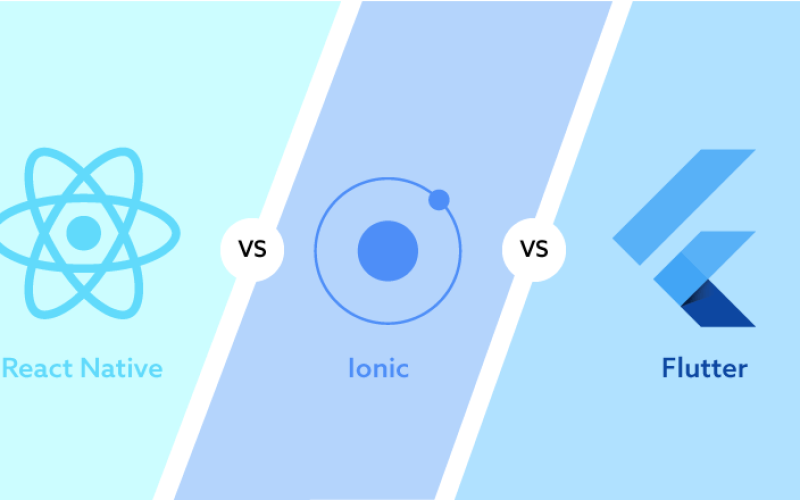Hybrid App Development: Flutter vs. React Native vs. Ionic

Flutter vs. React Native vs. Ionic – Which hybrid framework should you choose? Explore key differences, pros, cons, and best use cases.
Introduction
Hybrid app development allows developers to build cross-platform applications using a single codebase that runs on iOS and Android. Among the most popular frameworks are Flutter, React Native, and Ionic. Each has its strengths and weaknesses, making it essential to choose the right one based on project needs. This article compares these frameworks in terms of performance, development ease, and best use cases.
What is Hybrid App Development?
Hybrid app development combines elements of native and web applications, allowing developers to create mobile apps that work across multiple platforms. Unlike fully native apps, hybrid apps use a single codebase to target different operating systems, reducing development time and cost.
Flutter: Google's UI Toolkit
Overview
Flutter, developed by Google, is an open-source UI framework that uses Dart programming language. It allows for fast development with hot reload and offers a high-performance experience.
Key Features of Flutter
✅ Uses Dart for development
✅ Provides native-like performance
✅ Uses Skia rendering engine for smooth animations
✅ Strong support from Google and a growing community
Pros of Flutter
✔ Fast performance due to direct rendering
✔ Custom UI components for better app design
✔ Strong community support and frequent updates
✔ Best suited for visually rich applications
Cons of Flutter
❌ Large app size compared to React Native and Ionic
❌ Limited third-party libraries compared to older frameworks
❌ Dart is less popular than JavaScript, making hiring developers harder
Best Use Cases for Flutter
- Apps that require high-performance animations and UI
- Applications with custom UI designs
- Startups looking for fast MVP development
React Native: Facebook’s JavaScript Framework
Overview
React Native, developed by Facebook (Meta), is a JavaScript-based framework that allows developers to use React for building mobile applications. It provides a native-like experience while allowing code reuse.
Key Features of React Native
✅ Uses JavaScript and React for development
✅ Supports hot reloading for fast debugging
✅ Leverages native modules for improved performance
✅ Strong backing from Meta and the developer community
Pros of React Native
✔ Code reuse between mobile and web apps
✔ Large community support and extensive third-party libraries
✔ Better performance than Ionic for mobile apps
✔ Used by top brands like Instagram, Airbnb, and Tesla
Cons of React Native
❌ Performance lags compared to Flutter
❌ More dependency on third-party plugins
❌ Limited support for complex animations
Best Use Cases for React Native
- Apps requiring code sharing between web and mobile
- Applications with moderate UI and performance needs
- Businesses looking for quick market deployment
Ionic: Web Technologies for Mobile Apps
Overview
Ionic is a popular hybrid framework that leverages HTML, CSS, and JavaScript for mobile development. It works alongside Angular, React, or Vue and uses WebView for rendering applications.
Key Features of Ionic
✅ Uses HTML, CSS, and JavaScript
✅ Supports multiple frameworks like Angular, React, and Vue
✅ Provides pre-built UI components
✅ Leverages Capacitor and Cordova for accessing native features
Pros of Ionic
✔ Easiest to learn for web developers
✔ Fast development cycle with web technologies
✔ Wide range of UI components
✔ Best for Progressive Web Apps (PWAs)
Cons of Ionic
❌ Performance issues compared to Flutter and React Native
❌ Heavily dependent on WebView, affecting native experience
❌ Limited access to native APIs without additional plugins
Best Use Cases for Ionic
- Apps that function as Progressive Web Apps (PWAs)
- Simple applications that don’t require high performance
- Teams with strong web development experience
Flutter vs. React Native vs. Ionic: A Feature Comparison
| Feature | Flutter | React Native | Ionic |
|---|---|---|---|
| Language | Dart | JavaScript | HTML, CSS, JS |
| Performance | High | Medium | Low |
| UI Customization | High | Medium | Low |
| Code Reusability | Moderate | High | High |
| Best For | Visually rich apps | Web & mobile integration | PWAs & lightweight apps |
| Learning Curve | Moderate | Easy | Very easy |
Which One Should You Choose?
Choose Flutter if:
✔ You need high-performance and smooth animations
✔ You want a custom UI experience
✔ You are building a long-term app with strong Google support
Choose React Native if:
✔ You need code reuse between web and mobile
✔ Your team is familiar with JavaScript and React
✔ You need better third-party plugin support
Choose Ionic if:
✔ You are building a Progressive Web App (PWA)
✔ Your team has web development experience
✔ You need to develop simple apps quickly
Conclusion & Future Scope
Each of these frameworks serves a different purpose. Flutter is best for high-performance, UI-heavy apps, React Native offers a balance between performance and web compatibility, and Ionic is ideal for PWAs and simple applications. As hybrid app development evolves, these frameworks will continue to improve with better performance, easier integrations, and more powerful development tools.
Keywords
Hybrid app development, Flutter vs React Native vs Ionic, best cross-platform framework, mobile app development, hybrid apps, Flutter vs React Native, Ionic vs React Native, mobile development frameworks, best hybrid framework.



Write A Comment
No Comments